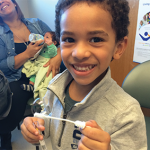Juvenile idiopathic arthritis (JIA) is the most common pediatric rheumatic disease, and polyarticular JIA (pJIA) is associated with a high risk of persistently active disease that may result in joint damage and permanent disability. Improving outcomes for children with pJIA is an important area of research.
In the previously published Start Time Optimization of biologics in Polyarticular JIA (STOP-JIA) study, researchers compared the effectiveness of the Childhood Arthritis and Rheumatology Research Alliance (CARRA) consensus treatment plans for untreated pJIA for achieving ACR clinically inactive disease off of glucocorticoids at 12 months. The treatment plans differed in the introduction of biologic disease-modifying anti-rheumatic drug (DMARD) therapy for patients as shown below:
- Step-up: Initial treatment with conventional synthetic DMARD monotherapy and the addition of a biologic DMARD at or after three months, if needed;
- Early combination: Initial treatment with both a conventional synthetic and a biologic DMARD; and
- Biologic first: Initial treatment with biologic DMARD monotherapy.
The results of STOP-JIA suggested that an earlier introduction of biologic DMARDs for children with pJIA may have a benefit and that the choice of initial consensus treatment plan may reduce overall disease burden.
In this follow-up study, using data from STOP-JIA, Ringold et al. sought to measure the effects of these consensus treatment plans and the timing of biologic DMARD introduction on the disease outcomes of these patients through a three-year period.
Methods
Study patients had to have participated in the STOP-JIA study and have a CARRA Registry follow-up through three years. Outcome measurements included ACR clinically inactive disease off glucocorticoids, clinical Juvenile Arthritis Disease Activity Score based on 10 joints inactive disease (cJADAS-10-ID) showing inactive disease (≤2.5), clinical remission on medication and the proportion of time in clinically inactive disease and/or cJADAS-10-ID ≤2.5.
Latent class trajectory modeling (LCTM) was applied to identify participant subgroups sharing similar disease courses over this period.
Results
In total, 297 participants were included in the study: 190 treated with the step-up consensus treatment plan, 76 treated with the early combination consensus treatment plan and 31 treated with the biologic first consensus treatment plan. At the three-year visit, clinically inactive disease was achieved by 35%, 42% and 44%, respectively (P=0.35 for step-up vs. early combination).
The early combination treatment plan was superior to the step-up plan in achieving clinical remission on medication (59.9% vs 40.6%; P=0.012), time spent in clinically inactive disease (38% vs. 30%; P=0.04) and cJADAS-10-ID scores ≤2.5 (51% vs. 41%; P=0.02). Slow, moderate and rapid improvement trajectories were identified in patients via LCTM. Biologic DMARD initiation within the first (odds ratio [OR]: 5.33) or second (OR: 2.67) month from baseline was associated with a rapid improvement trajectory.

